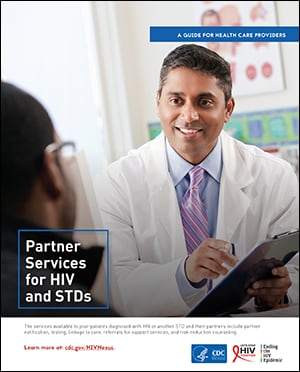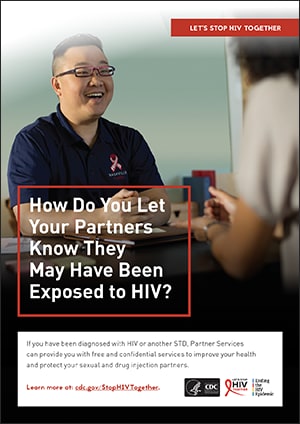Key points
- CDC recommends all patients between the ages of 13 and 64 get tested for HIV at least once as part of routine health care.
- Screen patients who may have ongoing risk factors for HIV at least annually.
- Use “opt-out” approach to remove stigma associated with HIV testing and foster earlier diagnosis and treatment.
- Try conversation starters to talk with your patients about routine HIV screening.
- Know your state’s HIV testing laws and regulations.

Overview
Benefits of routine screening include:
- HIV is a serious health disorder that can be detected before symptoms develop.
- HIV is detectable by reliable, inexpensive, acceptable screening tests.
- People diagnosed with HIV have years of life to gain if treatment is started before symptoms develop.
- Screening costs are reasonable in relation to proven benefits.
Offer HIV screening to all your patients
HIV crosses the boundaries of sexual orientation, gender, age, and ethnicity. More than 1 million people in the United States have HIV, and many are unaware of their status. About 40% of new HIV infections are transmitted by people who are unaware they have HIV.1 Diagnosing HIV quickly and linking people to treatment immediately are crucial steps to reducing new HIV infections.1
Start the conversation with your patients
Offering HIV screening to all patients helps eliminate stigma associated with HIV testing and creates opportunities to foster discussions.

Conduct more frequent screenings for your patients with certain risk factors for HIV
Patients who engage in certain behaviors may increase their chances of acquiring HIV and should be screened at least annually.23 Patients who engage in the following behaviors may have a greater chance of getting HIV:
- People who inject drugs and their sex partners.
- People who exchange sex for money or drugs.
- Sex partners of people with HIV.
- Sexually active gay, bisexual, and other men who have sex with men (more frequent testing may be beneficial [e.g., every 3–6 months]).
- Heterosexuals who themselves or whose sex partners have had ≥1 sex partner since their most recent HIV test.
- People receiving treatment for hepatitis, tuberculosis, or a sexually transmitted infection.
An HIV risk assessment should be included as part of routine primary care visits for all your sexually active patients. This will help determine the needs for more frequent screening and prevention counseling.
- Prevention counseling may also be needed for patients whose behaviors increase their chances for acquiring HIV.
- People receiving treatment for hepatitis, tuberculosis, or a sexually transmitted infection may have a greater chance of getting HIV.
- People who inject drugs may also be more likely to get HIV. Heroin use has increased substantially in recent years. The heroin and prescription opioid epidemics have led to new HIV outbreaks.45
- Routine screening offers you an opportunity to screen patients who may be reluctant to discuss or disclose risk factors.
Use an "opt-out" approach
Risk-based screening may fail to identify some people with HIV. These people include women, members of minority races/ethnicities, nonurban dwellers in low-incidence areas, and people under 20 years of age. It also includes heterosexual men and women who are unaware of their likelihood of getting of HIV. As a result, many people with HIV are not diagnosed until they have advanced HIV or AIDS.
Routine, opt-out screening has proven to be highly effective because it:
- Removes the stigma associated with HIV testing.
- Fosters earlier diagnosis and treatment.
- Reduces chances of transmission.
- Is cost-effective.
Inform patients (e.g., through a patient brochure, practice literature/form, or discussion) that an HIV test will be included in the standard preventive screening tests. Be sure to let them know that they may decline the test.2 A patient's decision to decline testing should be noted in their medical record. HIV prevention counseling is not a requirement for HIV testing.
Know your state's HIV testing laws
HIV testing laws vary from state to state. Some state laws require that health care providers offer all patients a voluntary (opt-out) HIV test. Each state also has specific HIV test reporting laws and regulations. Your state may also require that the partner(s) of a patient who tests positive for HIV be notified of the patient's HIV diagnosis.
For current details on state HIV testing laws and policies, consult CDC's resource on state laws affecting HIV prevention efforts. You can also contact your health department.
Recommended tests
HIV testing is easier than ever.
- Three types of HIV tests are available.
- Each type of HIV test has its own testing window, with the nucleic acid tests (NAT) capable of detecting HIV the earliest.
- HIV self-tests are also available for patients who want to test at home or in a private location.
- Nucleic acid tests (NATs) detect HIV ribonucleic acid (RNA).
- Antigen/antibody combination tests detect HIV p24 antigen as well as HIV immunoglobulin M (IgM) and immunoglobulin G (IgG) antibodies.
- Antibody tests detect HIV IgM and/or IgG antibodies.
Today's diagnostic tests reduce the time to diagnosis and treatment of early HIV infection by decreasing the window period.67 Following an exposure that leads to HIV infection, the time during which no diagnostic test can detect HIV is called the eclipse period.7 In contrast, the window period is the time between a potential HIV exposure and an accurate test result.

Learn more about FDA-approved HIV tests.
Patients who want to test at home or in a private location can use an HIV self-test
A rapid self-test is done entirely at home or in a private location and can produce results within 20 minutes. Your patients can buy a rapid self-test kit at a pharmacy or online. The only rapid self-test currently available in the United States is an oral fluid test. To learn more, visit the OraQuick website.
Next steps
HIV screening is the first step in CDC's status-neutral approach to prevention and care8
It all starts with an HIV test, but routine HIV screening is only the first step. To improve their health outcomes, people must have access to the full continuum of HIV prevention and care.
Linking your patients to prevention and care services is essential.2 The HIV prevention and care continuum is an ongoing, lifelong process that encompasses HIV testing, prevention, and care. CDC's status-neutral approach to HIV prevention and care ensures everyone receives quality HIV prevention and care, regardless of HIV status.
- Patients who have negative HIV tests should be offered prevention tools.
- Patients who have positive HIV tests should be linked to HIV treatment and care.

Patients who test negative can benefit from HIV prevention resources
Health care providers screening for HIV play a key role in improving outcomes throughout the HIV prevention and care continuum.9 For patients with a negative HIV test result, assess their needs and risk factors. Then, link them to prevention tools, such as PrEP, condoms, and risk-reduction counseling. Retain these patients in ongoing prevention services. Re-test them for HIV as long as they have ongoing risk factors.
Patients who test positive can benefit from early HIV diagnosis
Not all people with HIV are getting the care and treatment they need. For those with a positive HIV test result, studies have demonstrated the benefits of early HIV diagnosis in terms of patients' health outcomes.1011 Link patients newly diagnosed with HIV to treatment and care services so that they can start antiretroviral therapy (ART).1112
ART reduces HIV-associated morbidity and mortality
CDC recommends that people start treatment as soon as possible after diagnosis to gain maximum benefit from ART. Evidence suggests starting ART before advanced immunodeficiency is one of several interventions that reduces the risk of serious non-AIDS events. These events include cardiovascular disease, renal disease, hepatic disease, and cancer, as well as lowers the risk of mortality.13 Untreated HIV replication increases chances of serious non-AIDS events.131415
Resources
Materials for you and your practice
Materials for your patients
- Centers for Disease Control and Prevention. Estimated HIV incidence and prevalence in the United States 2015–2019. HIV Surveillance Report: Supplemental Report. 2021;26(1). https://www.cdc.gov/hiv/pdf/library/reports/surveillance/cdc-hiv-surveillance-supplemental-report-vol-26-1.pdf
- Branson B, Handsfield HH, Lampe MA, et al. Revised recommendations for HIV testing of adults, adolescents, and pregnant women in health-care settings. MMWR Morb Mortal Wkly Rep. 2006;55(RR14):1-17. https://www.cdc.gov/mmwr/preview/mmwrhtml/rr5514a1.htm
- DiNenno EA, Prejean J, Irwin K, et al. Recommendations for HIV screening of gay, bisexual, and other men who have sex with men – United States, 2017. MMWR Morb Mortal Wkly Rep. 2017;66(31):830-832. https://www.cdc.gov/mmwr/volumes/66/wr/mm6631a3.htm
- Centers for Disease Control and Prevention. CDC Vital Signs: HIV and injection drug use. Published December 2016. Accessed June 28, 2018. https://www.cdc.gov/vitalsigns/pdf/2016-12-vitalsigns.pdf
- Substance Abuse and Mental Health Services Administration. Results from the 2013 national survey on drug use and health: summary of national findings. Accessed June 28, 2018. https://www.samhsa.gov/data/sites/default/files/NSDUHresultsPDFWHTML2013/Web/NSDUHresults2013.pdf
- Hurt CB, Nelson JAE, Hightow-Weidman LB, Miller WC. Selecting an HIV test: a narrative review for clinicians and researchers. Sex Transm Dis. 2017;44(12):739-746. https://journals.lww.com/stdjournal/Fulltext/2017/12000/Selecting_an_HIV_Test__A_Narrative_Review_for.5.aspx
- Branson BM, Owen SM, Wesolowski LG, et al. Laboratory testing for the diagnosis of HIV infection: updated recommendations. Centers for Disease Control and Prevention. Published June 2014. Accessed June 28, 2018. https://stacks.cdc.gov/view/cdc/23447
- The White House. National HIV/AIDS strategy for the United States 2022–2025. Published 2021. Accessed February 2, 2022. https://www.whitehouse.gov/wp-content/uploads/2021/11/National-HIV-AIDS-Strategy.pdf
- Centers for Disease Control and Prevention. Monitoring selected national HIV prevention and care objectives by using HIV surveillance data: United States and 6 dependent areas, 2019. HIV Surveillance Report: Supplemental Report. 2021;26(2). https://stacks.cdc.gov/view/cdc/107935
- Bavinton B, Grinsztejn B, Phanuphak N, et al, for the Opposites Attract Study Group. HIV treatment prevents HIV transmission in male serodiscordant couples in Australia, Thailand and Brazil. Presented at the 9th IAS Conference on HIV Science; July 25, 2017; Paris, France.
- Rodger AJ, Cambiano V, Bruun T, et al., for the PARTNER Study Group. Sexual activity without condoms and risk of HIV transmission in serodifferent couples when the HIV-positive partner is using suppressive antiretroviral therapy. JAMA. 2016;316(2):171-181. https://jamanetwork.com/journals/jama/article-abstract/2533066?casa_token=u5s_q-3M5V4AAAAA:TwYakEQkz2vyYx-8ufv29tS2W79hw4L8IBgqETWU1wIdG_oiVTS_gvtnNo0wYEAEFnXtlnAxTw
- Panel on Antiretroviral Guidelines for Adults and Adolescents. Guidelines for the use of antiretroviral agents in adults and adolescents with HIV. Department of Health and Human Services. Accessed November 17, 2020. https://clinicalinfo.hiv.gov/sites/default/files/guidelines/documents/adult-adolescent-arv/guidelines-adult-adolescent-arv.pdf
- Hsu, D, Sereti I, Ananworanich J. Serious non-AIDS events: Immunopathogenesis and interventional strategies. AIDS Res Ther. 2013;10(29):217. https://link.springer.com/article/10.1186/1742-6405-10-29
- Triant VA. HIV infection and coronary heart disease: an intersection of epidemics. J Infect Dis. 2012;205:S355-S3618. https://academic.oup.com/jid/article/205/suppl_3/S355/937817?login=true
- Wyatt CM. Kidney disease and HIV infection. Top Antivir Med. 2017;25(1):13-16. https://pubmed.ncbi.nlm.nih.gov/28402929/







